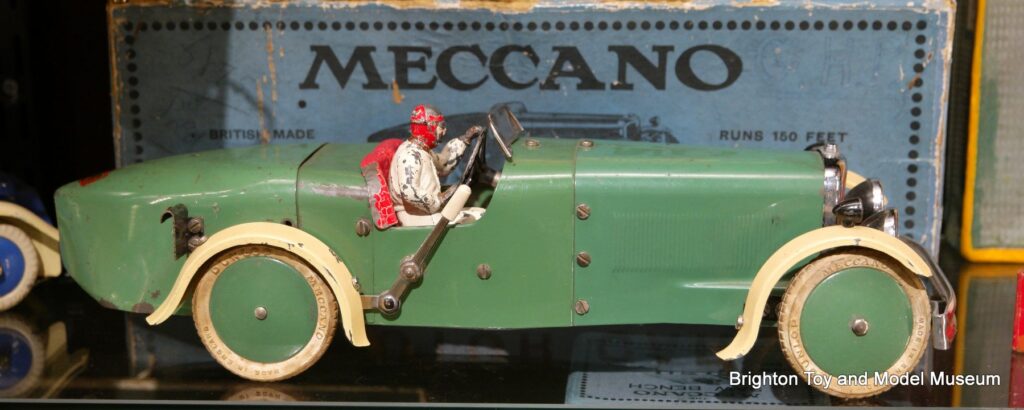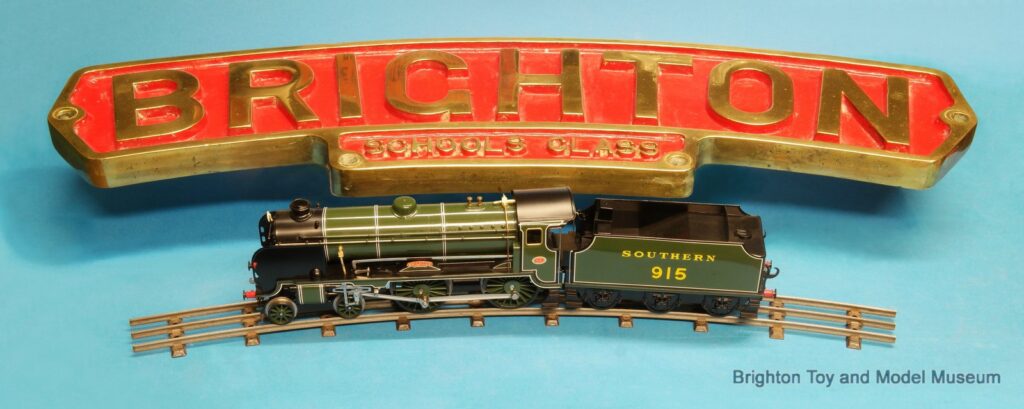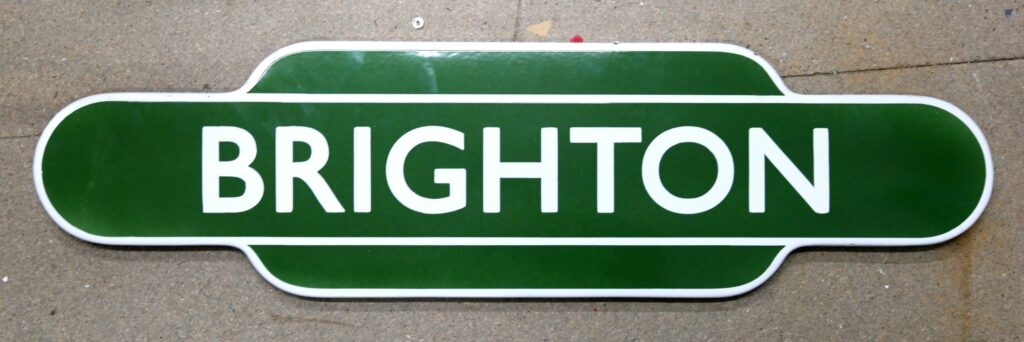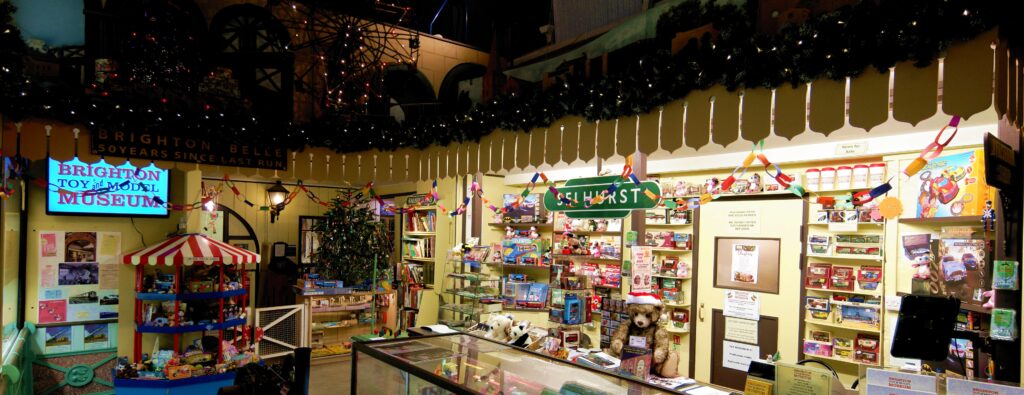

Back in 1971, Lego produced a range of Lego dollhouse furniture (“Lego Homemaker“), along with edge-studded baseplates that allowed users to build their own rooms, with or without walls.
We were particularly taken with the kitchen cooker with its eye-level hob, fold-down oven door, and pull-out baking tray. If the cooker is supposed to be built 4 2/3 bricks high (34mm), and a standard UK kitchen-top is 900mm, then scale comes out at around 1:26, which is close to a “small dollhouse” 1:24.
The idea was the children were supposed to play with the sets using their own (small) dolls, but in 1975, Homemaker got its own short-lived (and slightly creepy) Homemaker Lego figures, which were much larger than the later “minifigures“, and not nearly as successful.
Thanks to a number of generous donations over the last few years, we’ve now been able to upgrade the Pelham Puppets displays to show off around fifty of the marionettes, with a new wire mesh ceiling allowing us to pack much more into the space.
The 1968 LGB model railway format (“Lehmann Gross Bahn“, “Lehmann Big Train“) is a large (1:22.5-scale) weatherproof garden railway format that runs on brass gauge 1 (45 mm) track (the “G” either stands for “Grosse” or “Garden“). The LGB range tends to focus on narrow-gauge railways, either Swiss or US., to justify the proportionally larger-scale superstructure.
This is another temporary display while we wait for Cabinet 38 to be redesigned and rebuilt.
The first Paddington book appeared in 1958, and “Paddington Bear” rapidly went on to become an important part of British cultural identity. While we’re structurally redesigning the two far cabinets, one is being used to display a Paddington collection that has just been donated to us.
Both cabinets need to be rebuilt, but Paddington will be occupying one of them while we redesign and rebuild the other. We expect Paddington to remain in place for perhaps four weeks … maybe more, maybe less, depending on how all the other work goes.
Our normal cutoff date of the late 1960s for commercially produced toys doesn’t apply to models. This is a recent donation of three Astra satellite contractor models, given to key people who worked on the projects.
Astra 1A, launched in December 1988, started carrying Sky’s first multi-channel satellite broadcasts in the UK in early 1989.
The Supersonic and Dan Dare spaceship kits seem to be closely related, although they were produced by different companies. They are thematically similar, both seemed to appear in 1954 , and they even have almost identical boxes, although the key components are (deliberately?) different.
We assembled this “Supersonic” model parts from isolated and previously un-identified parts lurking at the bottom of various boxes of donated Meccano, which gave us examples of all the Supersonic parts other than the folding undercarriage pieces. All of the part types have been used in the model: the blue wheels have been stacked and used to extend the rocket motor, and the small red wheel in the set has been used to represent a lit end of the rocket engine.

Dan Dare: Pilot of the Future first appeared in Eagle comic in April 1950, and provided British audiences with their weekly dose of space adventures, before shows like Lost in Space and Star Trek took science fiction to the TV screen, and the USSR and US space programmes made space travel reality.
We’ve had a rather abbreviated and stumpy version of this metal 1954 Dan Dare kit rocket on display for some time. Now, after a renovation, it’s at last a decent spaceship!
We’ve recently finished some restoration work on a James Beeson gauge 0 model of 4-4-0 locomotive LNER 8900, with “John Herivel” on the nameplate. As far as we know the real loco never carried this name, suggesting that this may have been a special presentation model.
Unfortunately, we don’t know the backstory. John Herivel was one of the best-known codebreakers at Bletchley Park. Does anyone out there know the story of how this model came to bear his name?
The Sarah Leather Collection of lithographed tinplate novelty biscuit tins is now owned by the Littledale Brough Trust, and the display has been reorganised and improved.
This collection showcases the ingenuity and artistry of early Twentieth Century lithographic work, and includes Lewis Carroll -authorised “Alice Through the Looking Glass” tins from the 1890s.
After being off-display for some time, our diorama of Tri-ang Minic Ships is back on view.
We had to partially rebuild the cabinet after some damage, and took the opportunity to give everything a good dust.
We now have three rare MME sets on display, in colour-printed tinplate boxes. Mechanics Made Easy was the construction set system invented by Frank Hornby in 1901, that acquired the more memorable name Meccano in around 1908. Meccano Ltd. went on to become the world’s biggest toy company, and Hornby went on to create Hornby Trains, Hornby Dublo, and Dinky Toys.
Blurring the lines between toys, and models, and real things that are just really, really small, the museum’s lobby will be displaying Alex Orchin’s Peel P50, the world’s smallest production car, for the next six months.
The teensy car’s arrival was featured on Danny Pike’s show on BBC Radio Sussex, and was shown on BBC South East Today Evening News (it’s at the end of the segment).

Our seasonal display of snowy Christmas/Winter Lego sets is now back on show.
Lego fans might be interested to know that the flashing lights on the Christmas tree are wireless LEDs inside standard clear Lego bricks. The tiny stand-alone LEDs each have their own built-in power receivers, using the same induction-coil technology as wireless mobile phone chargers.

We now have a new banner across the bridge at the top of Trafalgar Street, to tell people where we are. It replaces the older one that was vandalised earlier this year.
The new one has been made possible by generous help from Brighton Bricks and Southern Rail UK.


Things will be a little quiet on the “display updates” front for the next few months, as most of our efforts between now and the end of the year (and maybe into January) will be spent on preparing a new non-public workspace for the use of inventory volunteers.
We’ll be scraping and treating walls, recladding, levelling floors, woodworking, repainting pretty much everything, and generally reorganising.

From 1932 onwards, Meccano Ltd. produced dedicated ranges of Motor Car Constructor and Aeroplane Constructor kits. The car kits were nicely enamelled, had their own clockwork motors and steering, and came in a range of four colour schemes and two sizes. Since they were slightly fiddly to make, the company could also supply the main designs ready-built. This is a boxed, factory-prebuilt example using parts from the No.2 Outfit. These sets weren’t produced again after World War Two.

The tradition of 1:72 plastic model aircraft kits didn’t start with Airfix, but with a company called International Model Aircraft, and their brandname FROG. IMA were partly owned by Tri-ang, and operated out of their Merton factory, using the central football field to test their flying aircraft models. The logo for these models was a winged frog, representing the acronym Flies Right Off Ground (i.e. no launcher required).
IMA then bought a plastic injection moulding machine to make their propellers (because wooden ones kept breaking), and once they had the machine, starting casting around for other things to use it for. After playing with some of the 1:72 Skybirds wood-and-metal model aircraft kits, they decided to try making something similar in plastic, and a new genre was born. Since the new models didn’t fly, IMA invented a sub-brand named after a non-flying bird, making them FROG Penguins – possibly the toy industry’s most confusing brand-name ever.
Work continues on the new aviation cabinet, labelling and interpretation will continue to improve over the next few months.

The Skybirds range of wooden aircraft kits, distributed by London-based A.J. Holladay & Co. Ltd., pioneered the use of 1:72 as a standard scale for aircraft models. The range was the brainchild of the absurdly talented aircraft modeller, illustrator and journalist James Hay Stevens (1913-1973), who launched the range in 1932 when he was only eighteen or nineteen years old. Skybirds “rode the wave” of the rise of British aviation in the ‘Thirties , and as new types of Art Deco airport and aerodrome building, and new support vehicles and infrastructure started to appear at the exciting new civilian aerodrome facilities at Brooklands, Heston Air Park and Gatwick, Skybirds produced corresponding models.
Skybirds became a phenomenon, with local clubs and newsletters and competitions, and as World War Two loomed, the Skybirds network was used to recruit for the RAF.

Britains Ltd. were originally best known for their toy soldiers, and after WW1 for their 1:32 scale farm animals, zoo animals, circus figures and garden sets. A lesser-known episode in the history of Britains was their production in the 1930s of lead-and-tinplate 1:32 aeroplanes and accessories, including anti-aircraft personnel. The most desirable items in this range were probably the Barrage Balloon and Lorry sets, consisting of a large suspendable Barrage Balloon and its lorry and winch.

The Southern Railway 4-4-0 “Schools Class” steam locomotive number 915 was named “Brighton” after Brighton College.
Southern are thought to have created three cast-brass “Brighton” loco nameplates for it: two for the loco and one to be donated to the school. One of these three was owned by beloved Brighton photographer and photojournalist legend Roger Bamber, who recently passed. He left it to us, and we will be proudly putting it up in the museum some time in April.
Brighton Museum and Art Gallery‘s special exhibition of Roger’s works, “Out of the Ordinary” opens on 1st April.

We used to regularly get asked why the old enamelled steel railway station sign over the shop counter said “SELHURST” rather than “BRIGHTON”. The simple reason was that we didn’t have one that said “Brighton”. Now we do. This one’s a repro, but it’s still pretty authentic.

We are now trialling our new Audio Guide!
Developed by Enhanced Experience, the guide has many minutes of professional audio outlining special stories around the museum, and costs £3.50

Something that everybody can be part of! For five pounds you can get hold of one of these lovely new enamelled metal badges to support the Trafalgar Street Regeneration Project.
Available now through the Museum Shop.

Unusually for us, we’ll be open during Christmas Week this year, with some restrictions (although we’re closed on Christmas Eve). As a result, we’ve decided to supplement the usual second-hand Collectors’ Market items with some brand new modern “Hornby Hobbies” stock, including a limited number of Hornby trains, Airfix kits and Scalextric (and Micro-Scalextric) sets, and some Corgi “Chitty Chitty Bang-Bang” cars.